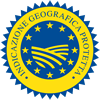Description
Salama da Sugo PGI is a charcuterie product made from a mixture of seasoned pork cuts stuffed into a natural pig’s bladder casing. Before drying and curing, two typologies are produced: Cruda (raw) and Cotta (cooked).
Production Area
The production area of Salama da Sugo PGI is within the territory of the Province of Ferrara, with the exclusion of the municipalities of Goro, Codigoro, Lagosanto and Comacchio, in the Emilia-Romagna region.
Production Method
The raw materials destined for the production of Salama da Sugo PGI must originate from pigs slaughtered at over 9 months old. Only selected meat cuts can be used, such as cheek, neck, bacon, shoulder, tongue and liver, in specified percentages and with the optional addition of minced picnic shoulder. The meat is seasoned in red wine that has been aged for less than 18 months. In addition to black pepper and coarse sea salt, other spices may be used (cinnamon, nutmeg and cloves), while brandy, grappa or rum can be used individually as a partial substitute for the red wine. The cuts are processed by hand, with the aid of a knife to ensure accurate trimming. The minced mixture – with a variable weight of between 1.2 and 2 kg – is stuffed inside the pig’s bladder. The stuffing process is carried out manually to ensure the integrity of the bladder, which is then tied with twine. The product is then dried and cured. For the Cotta version, the Salama da Sugo PGI is washed with hot water after the curing process to eliminate the traces of surface mould that form naturally during curing. The product is then packaged, with or without the bladder, either whole or in segments varying in weight, in a first flexible packet resistant to sterilization temperatures, and sealed, so as to contain the juices that come out during cooking. This is followed by heat treatment in an autoclave at a temperature between 115 and 121°C.
Appearance and Flavour
Salama da Sugo PGI has a characteristic round “melon” shape divided into 6-8 segments, with string tied tightly around the middle. At the end of the curing process it weighs between 700 g and 1.4 kg. The outer surface is uneven and may have traces of mould that form naturally during the curing process. It has a firm and compact consistency. It has an intense and extremely aromatic fragrance, with a full flavour and a lingering spicy aftertaste; the texture is soft and grainy.
History
The origins of Salama da Sugo date back to the Renaissance and can be linked to the court of the Dukes of Este, rulers of Ferrara from the 12th to 17th century, which gave a strong impetus to convivial entertainment. In 1722, a playful poem entitled La Salameide was published, in which the author, Antonio Frizzi, creatively explains the etymology of the name Salama and honours its Ferrara origins.
Gastronomy
Salama da Sugo PGI must be eaten after cooking. This applies to both the Cruda and Cotta typologies, although the method and preparation times are different. It should be served hot, removing the top and extracting the meat with a spoon, or removing the skin completely and placing the whole product on a cutting board, preferably indented so as not to lose the sauce while slicing. It is served with mashed potatoes, which can be dressed with the red sauce from the meat.
Marketing
The product is marketed as Salama da Sugo PGI Cruda, or Cotta. The cooked version is sold whole or in pieces.
Distinctive Features
The typical flavour and organoleptic properties of Salama da Sugo PGI formed during the curing process are determined by the preparation of the mixture, which involves the addition of red wine and spices such as cinnamon, nutmeg and cloves, as well as the seasoning of the casing.













